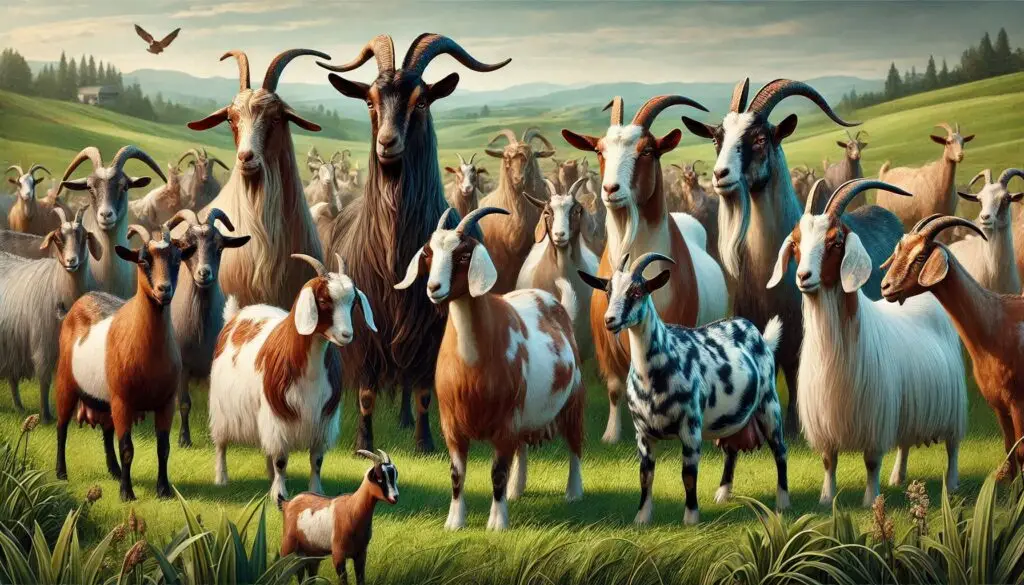Exploring Indian Goat Breeds

Introduction to Indian Goat Breeds
Goats are among the oldest domesticated animals, valued for their resilience and adaptability. In India, they thrive in various climates, from the arid deserts of Rajasthan to the lush fields of Kerala. Understanding the specific traits of each breed can help farmers make informed decisions about which Indian Goat Breeds to raise.
Importance of Goat Farming
Goat farming is an integral part of rural livelihoods in India. Goats require less space and resources compared to larger livestock. They are efficient converters of feed into protein-rich meat and milk. Additionally, goats can graze on marginal lands that are unsuitable for other forms of agriculture.
For more information on the benefits of goat farming, you can visit Pashudhan Praharee.
Major Goat Breeds in India
1. Jamunapari
Origin:
Jamuna River valley, Uttar Pradesh
Characteristics:
The Jamunapari goat is known for its large size and distinctive features such as long drooping ears and a convex face (often referred to as a “Roman nose”). They typically have a white body with patches of tan or black.
Production:
This breed is highly prized for its milk production capabilities. Jamunapari goats can yield between 2.25 to 2.7 kg of milk per day during lactation periods lasting approximately 250 days. They are also raised for meat.
For more details on Jamunapari goats, check out this Times of India article.
2. Sirohi
Origin:
Rajasthan
Characteristics:
Sirohi goats are medium-sized and well-adapted to arid conditions. They have a sturdy build and can thrive in harsh environments.
Production:
Primarily raised for meat, Sirohi goats provide moderate milk yields of about 0.4 to 0.5 kg per day.
3. Boer
Origin:
South Africa
Characteristics:
Boer goats are recognized for their fast growth rates and muscular build. They have a white body with red or brown heads.
Production:
Known for high-quality meat production, Boer goats are increasingly popular among Indian farmers due to their excellent growth performance.
4. Barbari
Origin:
Uttar Pradesh and Rajasthan
Characteristics:
Barbari goats are small to medium-sized with a compact body structure. They have erect ears and a straight profile.
Production:
This breed is valued for both its meat and milk production capabilities. Barbari goats can yield around 1 kg of milk daily.
For further insights on Barbari goats, visit Pashudhan Praharee.
5. Osmanabadi
Origin:
Maharashtra
Characteristics:
Osmanabadi goats adapt well to hot climates and have a medium size with varying coat colors (often black or spotted).
Production:
Primarily raised for meat, these goats also provide decent milk yields.
6. Black Bengal
Origin:
Eastern India (West Bengal)
Characteristics:
Black Bengal goats are small but prolific breeders known for their glossy black coats.
Production:
They are primarily raised for high-quality meat and skins but can also produce some milk.
For more information on Black Bengal goats, refer to the Agri Farming article.
7. Malabari
Origin:
Kerala
Characteristics:
Malabari goats are medium-sized with short coats that often feature a mix of colors.
Production:
They are valued for both meat and milk production, known for high fertility rates.
8. Beetal
Origin:
Punjab and Haryana
Characteristics:
Beetal goats are medium to large-sized with red or tan coloration.
Production:
This breed has high milk yields (up to 1.25 kg daily) along with good quality meat.
9. Jakhrana
Origin:
Jakhrana region, Uttar Pradesh
Characteristics:
Jakhrana goats are well-suited to hot climates and are larger in size compared to other breeds.
Production:
These goats primarily produce milk but also serve as good meat producers.
10. Gaddi
Origin:
Himachal Pradesh
Characteristics:
Gaddi goats thrive in hilly terrains and have a sturdy build suitable for mountainous areas.
Production:
Primarily raised for meat production, they adapt well to the local climate.
11. Marwari
Origin:
Rajasthan
Characteristics:
Marwari goats exhibit hardiness and adaptability to desert conditions.
Production:
While primarily raised for meat, they can also provide some milk under certain conditions.
Benefits of Raising Goats
Raising goats offers numerous benefits:
- Economic Viability: Goats require lower investment compared to cattle.
- Nutritional Value: Goat milk is nutritious and easier to digest than cow’s milk.
- Sustainable Farming Practice: Goats can graze on land unsuitable for crops.
- Diverse Products: Farmers can produce not only meat but also milk, fiber (like cashmere), and skins.
- Quick Reproduction Rates: Goats typically have shorter gestation periods (around five months) and can give birth to twins or triplets frequently.
For additional information on the benefits of goat farming practices, you may explore resources such as TNAU Agritech Portal or ScienceDirect.
Conclusion
Understanding the different goat breeds in India is essential for farmers looking to optimize their livestock management practices(Indian Goat Breeds). Each breed has unique traits that make it suitable for specific environments and agricultural needs. By selecting the right breed based on local conditions and market demands, farmers can enhance productivity while contributing positively to rural economies.
More from Genetics and Animal Breeding:
Pedigree Selection in Livestock





Responses